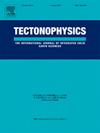Interplay between lateral extension and subsidence in large pull-apart basins resolved by 3D numerical modeling of the Dead Sea Basin
IF 2.6
3区 地球科学
Q2 GEOCHEMISTRY & GEOPHYSICS
引用次数: 0
Abstract
The evolution of large and deep interplate pull-apart basins is commonly associated with crustal extension, which promotes subsidence, sediment accumulation, Moho uplift, and elevated heat flux. However, the Dead Sea Basin departs from this tectonic model with a relatively cold and thick crust and earthquake activity down to the Moho at ∼30 km depth. The Dead Sea basin is subdivided into two sub-basins, with its deepest part at the south. Supported by previous geological, geophysical, and seismological observations, we suggest that the modern tectonic geometry of the basin evolved in two general phases. The evolutionary phases are manifested in differences in the seismicity patterns, where in the north, the longitudinal faults merge at a depth (below 17 km). In contrast, in the south, the faults remain separated. To examine the contribution of the lateral extension to the basin subsidence, we apply 3-D numerical modeling, resulting in an insufficient subsidence rate (0.3 mm/year) to explain the thickness of the sediments (∼8 km). We test whether the lateral extension plus a hypothetical magmatic intrusion explains the observed anomalies in the basin structure. Our calculation suggests that the basin evolved by a combination of two phases in which the subsidence rates accelerated from 0.3 mm/year to 0.7 mm/year at ∼5 Ma. The northern part of the basin is formed by extensional tectonics, whereas a deep magmatic intrusion could have facilitated the subsidence in the southern part of the basin. We find that the relatively low lateral slip rates in the basin enabled the cooling of the intruded crust and increased its density, which in turn intensified the subsidence rate. This scenario highlights the interplay between lateral extension and subsidence in shaping the structural and seismic characteristics of large pull-apart basins and provides a plausible explanation for the unusual depth of the Dead Sea Basin.
死海盆地三维数值模拟研究了大型拉分盆地横向伸展与沉降的相互作用
大而深的板块间拉分盆地的演化通常与地壳伸展有关,地壳伸展促进沉降、沉积堆积、莫霍隆起和热通量升高。然而,死海盆地与这种构造模式不同,它的地壳相对寒冷和厚实,地震活动一直持续到约30公里深的莫霍区。死海盆地分为两个子盆地,最深处位于南部。在以往的地质、地球物理和地震观测的支持下,我们认为盆地的现代构造几何演化分为两个阶段。演化阶段表现在地震活动模式的差异上,在北部,纵向断层在深度(低于17公里)处合并。相反,在南部,断层仍然是分开的。为了研究侧向伸展对盆地沉降的贡献,我们采用了三维数值模拟,结果表明沉降速率(0.3 mm/年)不足以解释沉积物的厚度(~ 8 km)。我们验证了侧向伸展和假设的岩浆侵入是否解释了观察到的盆地结构异常。我们的计算表明,盆地的演化是两个阶段的结合,其中沉降速率在~ 5 Ma时从0.3 mm/年加速到0.7 mm/年。盆地北部是由伸展构造形成的,而盆地南部则可能是深部岩浆侵入造成的沉降。研究发现,盆地内相对较低的横向滑动速率使侵入地壳冷却,增加了侵入地壳的密度,从而加剧了沉降速率。这一情景强调了横向伸展和沉降在形成大型拉分盆地的结构和地震特征方面的相互作用,并为死海盆地不同寻常的深度提供了合理的解释。
本文章由计算机程序翻译,如有差异,请以英文原文为准。
求助全文
约1分钟内获得全文
求助全文
来源期刊

Tectonophysics
地学-地球化学与地球物理
CiteScore
4.90
自引率
6.90%
发文量
300
审稿时长
6 months
期刊介绍:
The prime focus of Tectonophysics will be high-impact original research and reviews in the fields of kinematics, structure, composition, and dynamics of the solid arth at all scales. Tectonophysics particularly encourages submission of papers based on the integration of a multitude of geophysical, geological, geochemical, geodynamic, and geotectonic methods
 求助内容:
求助内容: 应助结果提醒方式:
应助结果提醒方式:


